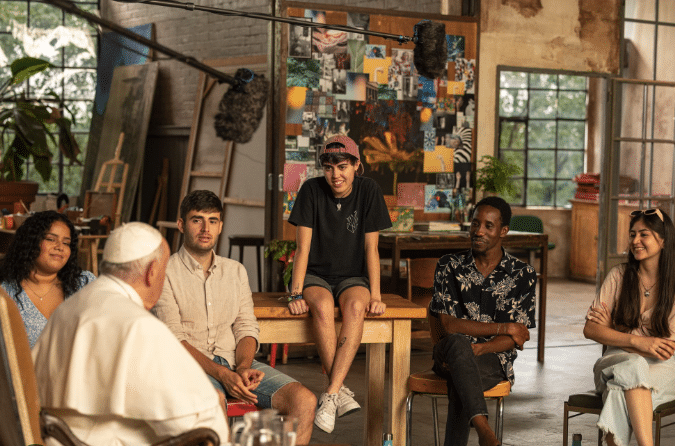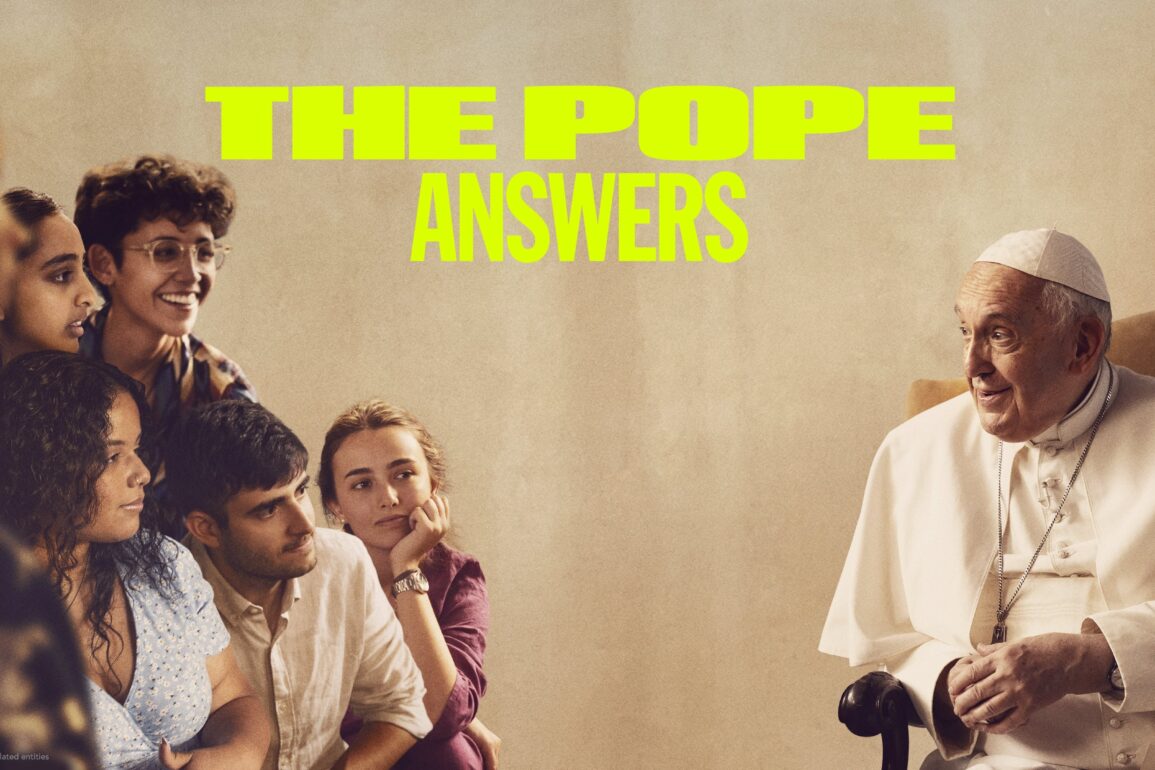The Disney+ channel presented the documentary “The Pope answers,” directed by the Spaniards Jordi Évole and Màrius Sànchez. In the documentary, Pope Francis is interviewed in Spanish by young people from different countries. When they applied to be selected, they expressed the questions they would like to ask the Pope. Out of 150 candidates from around the world, 10 were chosen by Évole and Sánchez. The concerns they brought to Francis were related to abortion, homosexuality, feminism, gender identity, among other issues.
The Pope did not avoid any answer, he let himself be carried away by the young people, in an attitude of listening and empathy, and in some cases, he expressed his thoughts clearly, as in the case of abortion.
Unprecedented in today’s communication
In the portal “Actualidad,” Jordi Évole reveals that “I was prepared, because of the relationship we had and because of the trust the Pope placed in us, to eliminate something, if he asked for it. It may be frowned upon for a reporter to say this, but I was considering editing something if he asked us to do so. Obviously, nothing major, but there are times when he looks awkward. He didn’t tell us to retouch any looks or gestures. He didn’t ask for anything. This is unprecedented in today’s world of communication.”
A courageous pope in the face of the reality of the world
In an interview with Elperiodico.com, Évole said: “That he had objections was even logical because of the documentary. He doesn’t come out well at all times. And, on the other hand, seeing that he did not come out well, especially with some looks and gestures, he did not ask us to eliminate anything.
I think it’s very brave of him, especially when he had the possibility of suggesting that we take something out. There was not even a suggestion. He said that it reflected the reality, that this is the reality of the world and this diversity of young people is what exists. And he was happy to have been able to approach them. For him it had been another pastoral encounter.”
Criticism of Pope Francis and the directors
There was no shortage of critics of the Pope’s attitude in this interview, as is obviously to be expected. Thus Infocatólica, for example, questioned “What use is it for the Pope to give this kind of interview if he does not try to correct the error – with charity of course – of those who ask him questions?”
On Filmaffinity, Guilletaber gives the documentary one star out of 10, and says that “it does not provide any significant knowledge, but it does promote a manipulated and biased image of the Catholic Church,” while Kevin Sebastian (4/10 stars), laments that “out of so many varied women to take on behalf of Colombia, the woman they took is one who feeds prejudice, out of 30 million women they take one who is dedicated to pornography and Onlyfans.”
Finally, Nicolás Martin (1/10 star) said: “I can’t believe it. It’s the worst thing I’ve seen from Pope Francis, and I’ve seen some very bad things. It is very difficult to digest. It is impossible not to feel sadness, indignation and, above all, shame.”
José Antonio Rosas: an impassioned and compelling analysis
As soon as the documentary was released, articles and videos were published analyzing it. In one of these videos, José Antonio Rosas, general director of the Academy of Catholic Leaders, expresses his opinion about the production, the attitude of the Holy Father, the directors, and the young people. We share here the central parts of his opinion, and at the bottom, the link to the complete video of his contribution.
Rosas begins by saying that today I watched the new Disney Plus documentary “The Pope answers”, where Pope Francis meets with 10 Spanish-speaking young people between the ages of 20 and 25, from Spain, Senegal, Argentina, the United States, Peru and Colombia, who reflect the reality of the wounds and pains of the youth of our time. I must say that I approached this documentary provoked in large part by an inflammatory article from a “supposedly Catholic” publication that attacks the participation of the Holy Father in this production, sowing mistrust and subtly attacking him.
After watching 83 minutes of the program, I must say that once again Pope Francis takes us out of our comfort zone, he deeply moves us with his courage and audacity, but above all with his firm decision to embrace the wounds of all, without fear of criticism and misunderstanding, without fear of getting his hands dirty in order to go after those who suffer and cover their wounds. It seems to me that this production will remain as a real and living lesson on how to dialogue with the new generations.
The Pope was not afraid to leave the Vatican
Rosas goes on to analyze the Pope’s willingness to go out in search of young people.
The place: outside the Vatican. First of all, the conversation between the Pope and these young people takes place outside the Vatican. For this, the Pope is not afraid to leave the comfort or the protection that could have been given to him if he had done this same exercise, but controlled or supervised from one of the Vatican offices. No! He was not afraid to leave the Vatican and present himself – as Jesus did – fragile, uncovered and without any protection or precaution, to meet with young people that he did not choose, that he did not select, of whom he did not know their life story. It was a meeting that was also organized and convened by a film director who describes himself as an agnostic. And Francis did it, moreover, not in a religious place, as it could have been a temple. He did it in the middle of the world, at the crossroads, in the middle of a rainy Italian afternoon, in an apartment where he had to use the service elevator to go up.
About the young people, Rosas says:
Second: Young people: a portrait of the pains and sufferings of our times

However, it is another reading that I would like to invite you to make. The director, I don’t know whether he meant to or not, did an excellent exercise in bringing the Vicar of Christ face to face with the different dramas and sufferings of our young people today. And this is where the divine spark, the magic of the Spirit, begins. Christ, who is not afraid to look face to face the wounds produced by today’s media culture. The Pope who shows us that to heal the wounds we must first listen to them and touch them, with deep sympathy, with tenderness, recognizing even in the most conflictive and contradictory situations the core of truth that is in them. For example, when addressing the tragedy of abortion, the Pope, in order to initiate a dialogue with them, recognizes in these young women who are defending the right to abortion that they have a great sensitivity for human suffering.
Francis shows us how to go out to encounter humankind
This is not an apologetics class. Much less a debate between positions. What Francis is showing us is how to go to the encounter with humanity, both in what he speaks to them, and in the ways he addresses the young people, even in his looks and gestures. All this is very well recorded in the documentary.
Certainly, it must be said that the director does not allow us to listen to all the argumentation or answers that the Pope gives regarding each problem, as when the Pope begins to argue to answer about abortion, and they cut him off to go to the next topic, or the actions that the Church has taken to prevent abuse. But the documentary makes no pretense of teaching doctrine. Come on! The documentary is made by an agnostic director. Rather, the success of the documentary is in showing the firm decision to go out to meet these young people, listen to them and dialogue with them.
It seems to me that the primary audience of this documentary is certainly not teenagers who are being formed in the faith. It is not a Catholic documentary, of Catholic doctrine, but the main audience is for those of us who, as adults in the faith, have to learn to heal the wounds of our times, to learn what it means to be a “field hospital”, a Church that goes out, that puts a face to the concrete and real problems, that touches the suffering, confused and throbbing reality with tenderness.
Finally, his dialogue with the girl from the Neocatechumenal Way
Among the 10 young people, there is only one young woman who visibly has a cordial belonging to the Church, without conflicts, without discrepancies. She is a young Spanish woman who comes from a family of the Neocatechumenal Way. It is significant that she is “in the minority” in this dialogue, but isn’t this the reality we live in, where Christians are in the minority? And yet, we cannot stop courageously proposing our view of humanity, dialoguing and trying to convince through our own life. That is what we can see in this documentary with this young Spanish woman!
But I want to dwell on the message that Pope Francis addresses to this young woman, which moved those of us who saw the documentary. After she has given her testimony of all that she believes about life and sexuality to other young people who do not understand her, Pope Francis looks at her with tenderness. I want to note that he looks at her with the same tenderness that he looked at each one of the young people, regardless of whether they were believers or not, regardless of their positions or contradictions, Francis always looked at them with tenderness!
And the Pope, looking at her with tenderness, tells her “How brave you are to speak as you have done here!” The Pope recognizes that it is necessary to be courageous both to go out to meet all our brothers and sisters, and to never give up what we believe in.
Rosas closes video deeply touched by seeing the Pope healing hearts with tenderness
I strongly recommend that you watch this documentary. Certainly those who live encapsulated by the lenses of mistrust of an ideology will not be able to understand the richness of this documentary.
If we look at it with the eyes of faith, recognizing Christ who walks in the midst of the contradictions of life, we cannot fail to be moved, looking at Francis, with that deep peace of a man who wants to be a man of peace and not of wars, that good Samaritan, which we are all called to be, to see, touch and heal with tenderness the wounds of our time through encounter and fraternity.
The documentary “The Pope answers” (in Spanish, with subtitles in English) is available in the U.S. via Hulu. The Spanish version, “Amén, Francisco responde,” can be seen in Latin America through the streaming platform Star+, and in Spain via Disney+.
The National Catholic Council for Hispanic Ministry in the USA (NCCHM) has added English subtitles to both the trailer of the documentary, as well as José Antonio Rosas’ message. We share both here:










